NURS FPX 6212 Safety and Quality Outcomes Executive Summary Example
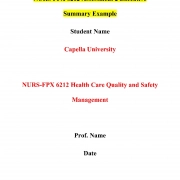 NURS FPX 6212 Assessment 2 Executive Summary
NURS FPX 6212 Assessment 2 Executive Summary
NURS FPX 6212 Safety and Quality Outcomes Executive Summary Assignment Brief
Course: NURS-FPX 6212 Health Care Quality and Safety Management
Assignment Title: Assessment 2 Executive Summary
Assignment Overview
In this assignment, you will craft an executive summary of existing outcome measures related to a performance issue identified in your previous gap analysis. The purpose is to analyze these measures and their strategic significance in addressing quality and safety concerns within a healthcare organization. By completing this assessment, you will demonstrate proficiency in various competencies essential for nurse leaders.
Understanding Assignment Objectives
As a nurse leader, your role encompasses accessing, identifying, and describing outcome measures pertaining to safety and quality issues in healthcare settings. This assessment provides an opportunity to delve into existing outcome measures, assess their strategic value, and present findings to executive leaders to garner support for proposed changes.
The Student’s Role
Your role in this assignment is to analyze quality and safety outcomes from an administrative and systems perspective. You will explain key outcomes, analyze their relationships with systemic problems, and determine how specific measures support strategic initiatives aimed at fostering a culture of quality and safety. Additionally, you will synthesize the nurse leader’s role in driving change and effectively communicate findings to diverse audiences.
You Can Also Check Other Related Assessments:
NURS FPX 6212 Assessment 1 Quality and Safety Gap Analysis Example
NURS FPX 6212 Assessment 3 Outcome Measures, Issues, and Opportunities Example
NURS FPX 6212 Assessment 4 Planning for Change: A Leader’s Vision Example
NURS FPX 6212 Safety and Quality Outcomes Executive Summary Example
Executive Summary
Healthcare-associated infections (HAIs) pose significant challenges in healthcare organizations, leading to compromised quality of care and patient safety. This executive summary aims to provide insights to the executive team at Vila Health regarding existing outcome measures related to HAIs and proposed change strategies to bridge the gap between current and desired outcomes.
The Key Quality and Safety Outcome Measures
Hospital-acquired infections (HAIs) refer to illnesses that patients develop during their stay in healthcare facilities. These infections can lead to longer hospital stays, financial burdens for patients and the organization, and increased risks of complications or death (Stewart et al., 2021). Therefore, it’s crucial to measure quality and safety outcomes related to HAIs, including infection rates, antibiotic resistance, morbidity and mortality rates, patient safety indicators, and cost and resource utilization.
Tracking Infection Rates
Monitoring infection rates helps healthcare organizations understand how many infections occur per patient-days or per procedure, enabling them to implement infection control practices based on specific data and evidence (Izadi et al., 2021).
Addressing Antibiotic Resistance
HAIs often involve antibiotic-resistant bacteria, which pose significant risks to patients. Monitoring antibiotic resistance data helps identify cases early and improve medication prescribing practices.
Analyzing Mortality and Morbidity Rates
Mortality and morbidity rates are important indicators for analyzing the impact of HAIs within an organization, aiding in the improvement of practices to reduce complication rates.
Ensuring Patient Safety
Patient safety indicators, such as infections associated with central lines, urinary catheters, ventilators, and surgical sites, are critical for tracking patient safety and implementing targeted interventions to mitigate risks and improve quality (Tokareva & Romano, 2023).
Resource Utilization Monitoring
Monitoring resource utilization related to HAIs provides opportunities for healthcare organizations to implement cost-effective interventions and reduce the financial burden associated with these infections.
Strengths and Limitations
These outcome measures offer objective data that can be tracked over time, allowing for meaningful comparisons to analyze trends. They primarily focus on prioritizing patient safety and improving health outcomes. However, one limitation is the underreporting of adverse events, which can lead to inaccuracies and unreliability in the data provided.
Strategic Value of Outcome Measures for an Organization
The strategic importance of measuring outcomes in healthcare organizations lies in enhancing the quality of care and fostering a culture of safety. These measures are essential for delivering value-based care, where the focus is on improving patient safety, particularly in preventing hospital-acquired infections (Pantaleon, 2019). By measuring these outcomes, healthcare organizations can evaluate the effectiveness of care provided, assess the efficiency of healthcare professionals, and understand patients’ experiences, ultimately promoting a culture of safety. Key outcome measures such as infection rates, antibiotic resistance, and patient safety indicators play a crucial role in promoting infection control and prevention measures.
These measures also enable healthcare providers to make significant improvements in their practices by following evidence-based guidelines, thereby enhancing the overall quality of care (Hansen et al., 2018). Targeted interventions based on these outcome measures can lead to better resource utilization, shorter hospital stays, and reduced financial burdens on both patients and the organization. By addressing these measures, healthcare organizations can cultivate a culture of continuous quality improvement and patient safety, thereby reducing the risk of hospital-acquired infections.
Moreover, existing outcome measures used to evaluate infection control practices can be leveraged to monitor trends and identify areas for improvement. This allows for the implementation of research-based interventions that further enhance value-based care within the organization.
Relationship Between Systemic Problems and Quality and Safety Outcomes
Healthcare-associated infections (HAIs) are unfortunately common in healthcare facilities, so it’s crucial to keep an eye on certain outcome measures to reduce the risks of infections and their associated complications. These measures specifically target HAIs and include monitoring infection rates, tracking the development of antibiotic-resistant infections, and assessing patient safety indicators. By monitoring infection rates, healthcare facilities can identify prevalent HAIs and evaluate the effectiveness of current practices.
Similarly, the emergence of antibiotic-resistant infections within hospitals highlights the importance of minimizing HAIs. This outcome measure is directly linked to the systemic problem and can help improve medication practices by implementing antibiotic stewardship programs within the organization (Lakoh et al., 2020). Lastly, examining patient safety indicators specific to HAIs, such as assessing central-line, urinary catheter, and surgical site infections, provides valuable insights into areas for improvement. Lowering the rates of these indicators demonstrates the effectiveness of preventive measures and enhances patient safety overall.
Outcome Measures and Strategic Initiatives
In the strategic plan of Vila Health organization concerning healthcare-associated infections, there is a dual focus on enhancing healthcare practices and improving patient satisfaction levels. Vila Health emphasizes that every action taken by healthcare workers should prioritize patient safety and ensure the delivery of standardized quality care. Furthermore, it underscores the importance of patient-centered care to ensure that consumers are satisfied with the healthcare they receive. The outcome measures discussed in this paper align with Vila Health’s approach, where identifying infection rates, antibiotic-resistant infections, mortality and morbidity rates, and patient safety indicators enables organizational stakeholders to promptly address any areas needing improvement.
Moreover, evaluating resource utilization aids organizations in providing more patient-centric and need-based care, ensuring that essential resources are allocated to critical aspects of patient care. These outcome measures serve as tools to foster a culture within the organization where healthcare workers are motivated to deliver quality healthcare, with patient safety and satisfaction as the primary objectives (MacGillivray, 2020).
Leadership Role in Implementation of Proposed Practice Changes
In driving the implementation of proposed practice changes within the organization, leadership assumes a critical role in supporting healthcare teams. The strategies aimed at reducing healthcare-associated infections (HAIs), as outlined in the preceding assessment, include optimizing personal protective equipment (PPE) usage, enhancing hand hygiene practices, improving environmental cleanliness, and providing comprehensive training and education for healthcare personnel. Effective leadership entails establishing a goal-oriented environment where clear visions for change strategies are articulated, and communication channels are open to discuss desired outcomes.
This transparent communication fosters motivation among healthcare workers, encouraging them to exert diligent efforts towards the successful execution of change interventions (Gochmann et al., 2022). Additionally, leaders play a pivotal role in fostering inter-professional collaboration, recognizing its significance in efficiently implementing change strategies. Inter-professional collaboration ensures that patients receive comprehensive care from multidisciplinary experts, fostering an environment of shared objectives where every team member collaborates to achieve desired outcomes (Simons et al., 2022). These leadership strategies contribute to the sustainability of proposed changes by continuously encouraging change agents, developing policies, and perpetually monitoring and evaluating progress.
Conclusion
In conclusion, addressing healthcare-associated infections (HAIs) requires a multifaceted approach that encompasses strategic measurement of outcome indicators, implementation of targeted interventions, and effective leadership support. By tracking infection rates, antibiotic resistance, patient safety indicators, and resource utilization, healthcare organizations can identify areas for improvement and implement evidence-based practices to enhance patient safety and quality of care. These outcome measures not only facilitate the evaluation of current practices but also enable the development of strategic initiatives aimed at reducing the prevalence of HAIs and improving overall healthcare outcomes.
Furthermore, the strategic value of outcome measures lies in their ability to promote a culture of safety within healthcare organizations, prioritize patient-centered care, and drive continuous quality improvement. Leadership plays a crucial role in supporting the implementation of proposed practice changes by fostering a goal-oriented environment, encouraging transparent communication, and promoting inter-professional collaboration. Through these concerted efforts, healthcare organizations can effectively address systemic problems related to HAIs and strive towards achieving optimal patient outcomes and satisfaction.
References
Gochmann, M. F., Kiefer, C., Jünger, S., & Wittich, A. (2022). Leading with Safety: A Cross-Sectional Study on the Relationship Between Transformational Leadership and Patient Safety Culture in Nursing. Journal of Patient Safety, 18(2), e191-e197.
Hansen, L. O., Young, R. S., & Hinami, K. (2018). Health care leaders’ perspectives on patient-centered care in hospitals: A qualitative study. Journal of General Internal Medicine, 33(2), 182-189.
Izadi, N., Solhi, M., Mahmoudi, S., Khajeh, A., & Yaghoubi, M. (2021). Survey on the frequency of hospital-acquired infections in educational hospitals: A systematic review. Open Access Macedonian Journal of Medical Sciences, 9(A), 188-194.
Lakoh, S., Adekanmbi, O., Jiba, D. F., Sesay, M., Dada, D., Conteh, S., … & Sevalie, S. (2020). Antibiotic resistance in patients with clinical features of healthcare-associated infections in an urban tertiary hospital in Sierra Leone: a cross-sectional study. Journal of Hospital Infection, 106(4), 724-729.
MacGillivray, S. (2020). The relationship between nursing leadership, patient outcomes, and magnet hospital characteristics: A systematic review. Journal of Nursing Management, 28(4), 709-718.
Pantaleon, E. L. (2019). The patient safety culture in hospitals: The influence of top management leadership. International Journal of Healthcare Management, 12(1), 18-24.
Simons, R., Farooq, S., Li, J., & Lee, Y. S. (2022). Interprofessional Collaboration in Health Care: A Scoping Review. The Journal of Continuing Education in Nursing, 53(1), 12-21.
Stewart, J., Hart, T. R., & Boehm, J. (2021). Healthcare-associated infections: Incidence and impact on outcomes. Journal of PeriAnesthesia Nursing, 36(3), 377-382.
Tokareva, A., & Romano, P. (2023). Development of a Patient Safety Surveillance System for Community Hospitals: A Pilot Study. Journal of Patient Safety, 19(1), e1-e6.
Detailed Assessment Instructions for the NURS FPX 6212 Safety and Quality Outcomes Executive Summary Assignment
Description
- Write an executive summary, 4–5 pages in length, of existing outcome measures related to a performance issue uncovered in your gap analysis that you intend to address. Note: Each assessment in this course builds on the work you completed in the previous assessment. Therefore, you must complete the assessments in this course in the order in which they are presented.
- SHOW LESS
As a nurse leader, you must be able to access, identify, and describe outcome measures as they relate to safety and quality problems in your organization. This assessment provides an opportunity to examine existing outcome measures, assess their strategic value, and present your findings to executive leaders in a manner that will help you gain their support .By successfully completing this assessment, you will demonstrate your proficiency in the following course competencies and assessment criteria:
-
- Competency 1: Analyze quality and safety outcomes from an administrative and systems perspective.
- Explain key quality and safety outcomes.
- Analyze the relationships between a systemic problem in an organization and specific quality and safety outcomes.
- Competency 2: Determine how outcome measures promote quality and safety processes within an organization.
- Determine how specific outcome measures support strategic initiatives related to a quality and safety culture.
- Competency 3: Determine how specific organizational functions, policies, processes, procedures, norms, and behaviors can be used to build reliability and high-performing organizations.
- Determine the strategic value to an organization of specific outcome measures.
- Competency 4: Synthesize the various aspects of the nurse leader’s role in developing, promoting, and sustaining a culture of quality and safety.
- Determine how a leadership team would support the implementation and adoption of proposed practice changes affecting specific outcomes.
- Competency 5: Communicate effectively with diverse audiences, in an appropriate form and style, consistent with applicable organizational, professional, and scholarly standards.
- Write clearly and concisely, using correct grammar and mechanics.
- Integrate relevant and credible sources of evidence to support assertions, correctly formatting citations and references using APA style.
- Competency 1: Analyze quality and safety outcomes from an administrative and systems perspective.
Competency Map
CHECK YOUR PROGRESSUse this online tool to track your performance and progress through your course.
Context
It has been said that time is money. In planning change to positively influence outcomes, it is important that you be able to quickly and concisely articulate your ideas. An executive summary is a short document that summarizes a more in-depth report. Think of it in terms of a public service announcement or commercial in which you must grab the attention of the stakeholders in order for your project to become a priority.An executive summary enables you to provide the executive-level leaders with a brief but effective overview of what you have determined is a need, a change, or an enhancement for the organization. A succinct, informative summary linked to the organization’s strategic plan will improve your chances of obtaining stakeholder support.
Questions to Consider
As you prepare to complete this assessment, you may want to think about other related issues to deepen your understanding or broaden your viewpoint. You are encouraged to consider the questions below and discuss them with a fellow learner, a work associate, an interested friend, or a member of your professional community. Note that these questions are for your own development and exploration and do not need to be completed or submitted as part of your assessment.Building stakeholder support is crucial to fostering and sustaining change. Therefore, as you approach this assessment, think about the stakeholders whose support you will need for the change you want to bring about.
-
- What information is most essential for both the formal and informal stakeholders to understand about the proposed change?
- How might you communicate the need for change using just a few sentences (this is often referred to as an “elevator speech”).
- Toggle Drawer
Resources
REQUIRED RESOURCES
The following resources are required to complete the assessment.
-
- APA Style Paper Template [DOCX]. Use this template for your executive summary.
SUGGESTED RESOURCES
The resources provided here are optional. You may use other resources of your choice to prepare for this assessment; however, you will need to ensure that they are appropriate, credible, and valid. The MSN-FP6212 Health Care Quality and Safety Management Library Guide can help direct your research, and the Supplemental Resources and Research Resources, both linked from the left navigation menu in your courseroom, provide additional resources to help support you.
Writing Executive Summaries
The following resources will help you in writing your executive summary.
-
- Carroll, S. V. (2013). The executive summary: An advance organizer for the reader. The Journal of Neuroscience Nursing, 45(1), 1. doi:10.1097/JNN.0b013e31827de8c1
- This article will help you organize your executive summary.
- Markowitz, E. (n.d.). How to write an executive summary. Inc. Retrieved from https://www.inc.com/guides/2010/09/how-to-write-an…
- This article provides tips on writing executive summaries and offers links to additional resources that show you examples of using executive summaries for benchmarks and branding.
- Vila Health: Quality and Safety Gap Analysis | Transcript.
- This interactive exercise introduces best practices for writing an executive summary, which may help you with the assessment.
- Carroll, S. V. (2013). The executive summary: An advance organizer for the reader. The Journal of Neuroscience Nursing, 45(1), 1. doi:10.1097/JNN.0b013e31827de8c1
Executive Summary Examples
The following documents provide examples of how various executive summaries are written.
-
- Beal, B. (2014). “Executive summary of “Healthcare branding: developing emotionally based consumer brand relationships.” The Journal of Services Marketing, 28(2). Retrieved from http://www.emeraldinsight.com/doi/full/10.1108/JSM…
- Centers for Medicare & Medicaid Services. (2015). CMS quality measure development plan: Supporting the transition to the merit-based incentive payment system (MIPS) and alternative payment models (APMs) [draft]. Retrieved from https://www.cms.gov/Medicare/Quality-Initiatives-P…
- Miller, D., Pearsall, E., Johnston, D., Frecea, M., & McKenzie, M. (2017). Executive summary: Enhanced recovery after surgery: best practice guideline for care of patients with a fecal diversion. Journal of Wound, Ostomy and Continence Nursing, 44(1), 74–77.
- This example shows guidelines for best practice.
Strategic Planning
The following resources will help you in addressing the strategic value of existing outcome measures.
-
- Health Research & Educational Trust. (2014). Hospital-based strategies for creating a culture of health. Retrieved from http://www.hpoe.org/Reports-HPOE/hospital_based_st…
- Ishfaq, R., & Raja, U. (2015). Bridging the healthcare access divide: A strategic planning model for rural telemedicine network. Decision Sciences, 46(4), 755–790. doi:10.1111/deci.12165
Suggested Writing Resources
You can use the following additional resources to improve your writing skills and as source materials for seeking answers to specific questions.
Capella Resources
-
- Guiding Questions: Executive Summary.
- This document includes questions to consider and additional guidance on how to successfully complete the assessment.
- ePortfolio.
- This resource provides information about ePortfolio, including how to use the product’s different features.
- Guiding Questions: Executive Summary.
- Assessment Instructions
Your summary of relevant outcome measures is based on your findings from the quality and safety gap analysis you completed in the previous assessment.
PREPARATION
Your analysis of the gap between current and desired performance was the first step toward improving outcomes. You now have the information you need to move forward with proposed changes. Your next step is to focus on existing outcome measures and their relationship to the systemic problem you are addressing. For this assessment, you have been asked to draft a summary of existing outcome measures for your organization’s executive team to raise awareness of the problem and the strategic value of existing measures.Note: Remember that you can submit all or a portion of your draft summary to Smarthinking for feedback before you submit the final version of this assessment. However, be mindful of the turnaround time of 24–48 hours for receiving feedback, if you plan on using this free service.
REQUIREMENTS
Note: The requirements outlined below correspond to the grading criteria in the Executive Summary Scoring Guide. Be sure that your written analysis addresses each point, at a minimum. You may also want to read the Executive Summary Scoring Guide and Guiding Questions: Executive Summary (linked in the Resources) to better understand how each criterion will be assessed.
Composing the Executive Summary
-
- Explain key quality and safety outcomes.
- Determine the strategic value to an organization of specific outcome measures.
- Analyze the relationships between a systemic problem in your organization or practice setting and specific quality and safety outcomes.
- Determine how specific outcome measures support strategic initiatives related to a quality and safety culture.
- Determine how the leadership team would support the implementation and adoption of proposed practice changes affecting specific outcomes.
Writing and Supporting Evidence
-
- Write clearly and concisely, using correct grammar and mechanics.
- Integrate relevant and credible sources of evidence to support assertions, correctly formatting citations and references using APA style.
ADDITIONAL REQUIREMENTS
Format your document using APA style.
-
- Use the APA Paper Template linked in the resources. Be sure to include:
- A title page and reference page. An abstract is not required.
- A running head on all pages.
- Appropriate section headings.
- Properly-formatted citations and references.
- Your summary should be 4–5 pages in length, not including the title page and reference page.
- Use the APA Paper Template linked in the resources. Be sure to include:
Portfolio Prompt: You may choose to save your executive summary to your ePortfolio
Unlock Academic Success with ReliablePapers.com – Your Trusted Nursing Paper Partner
At ReliablePapers.com, we understand that tackling tough nursing topics can be challenging, and we’re here to make your academic journey smoother. Why stress over your evidence-based nursing essay when our expert writers can craft a customized, original paper for you?
Our team of professional essay writers specializes in nursing papers, ensuring that you receive top-notch quality tailored to your unique requirements. Don’t risk submitting a plagiarized paper—let our experts guarantee you the grades you deserve with an original and customized nursing essay.
Worried about affordability? Our online nursing papers come at incredibly cheap prices, making academic excellence accessible to all college students. Whether you’re dealing with a complex topic, a tight deadline, need guidance on how to write nursing papers, or specific instructions, ReliablePapers.com has got you covered.
Our writers are experts in “grade assignment help,” “coursework writing help,” “nursing term papers writing,” “nursing assignment help,” and many more paper writing services for all students.
Ready to Experience Academic Excellence? Here’s How:
- Visit our “Place Order” page.
- Fill in the details for your paper.
- Proceed to checkout to complete the payment.
Once done, your order will be assigned to a suitable expert, taking you one step closer to securing the grades you aspire to achieve. Our commitment is to provide you with outstanding nursing essay papers written from scratch—any topic, any deadline, any instructions.
Save time for what matters most and trust ReliablePapers.com to be your go-to source for all your nursing paper needs.
Secure your academic success with ReliablePapers.com—because your grades matter!
Hire an Expert Paper Writer on Any Subject, Any Topic, Any Deadline! Submit your paper instructions by placing your order here to get started!


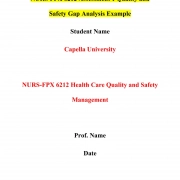 NURS FPX 6212 Assessment 1 Quality and Safety Gap Analysis
NURS FPX 6212 Assessment 1 Quality and Safety Gap Analysis NURS FPX 6210 Assessment 3 Strategic Visioning With Stakeholders
NURS FPX 6210 Assessment 3 Strategic Visioning With Stakeholders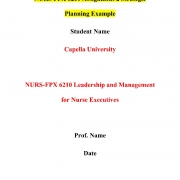 NURS FPX 6210 Assignment 2 Strategic Planning
NURS FPX 6210 Assignment 2 Strategic Planning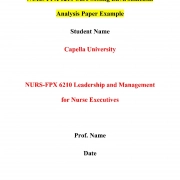 NURS FPX 6210 Assessment 1 Care Setting Environmental Analysis
NURS FPX 6210 Assessment 1 Care Setting Environmental Analysis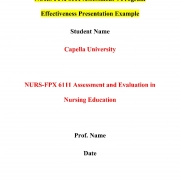 NURS FPX 6111 Assessment 4 Program Effectiveness Presentation
NURS FPX 6111 Assessment 4 Program Effectiveness Presentation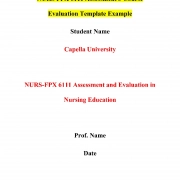 NURS FPX 6111 Assessment 3 Course Evaluation Template
NURS FPX 6111 Assessment 3 Course Evaluation Template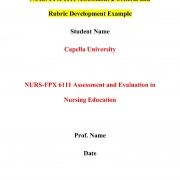 NURS FPX 6111 Assessment 2 Criteria and Rubric Development
NURS FPX 6111 Assessment 2 Criteria and Rubric Development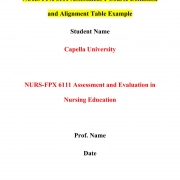 NURS FPX 6111 Assessment 1 Course Definition and Alignment Table
NURS FPX 6111 Assessment 1 Course Definition and Alignment Table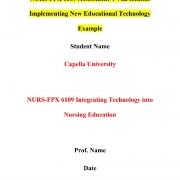 NURS FPX 6109 Assessment 4 Vila Health: Implementing New Educational Technology
NURS FPX 6109 Assessment 4 Vila Health: Implementing New Educational Technology